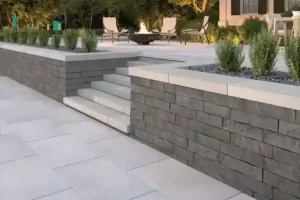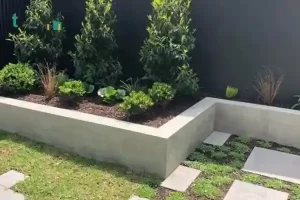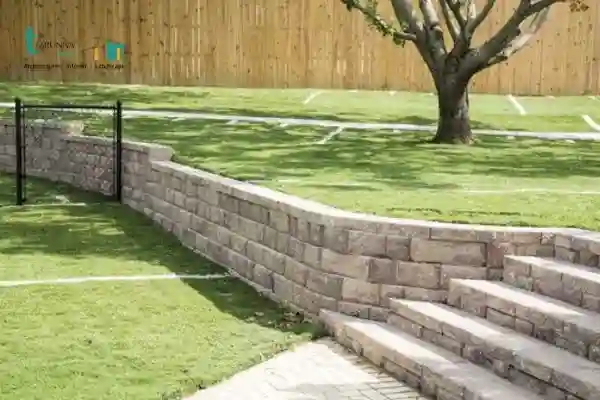 Retaining walls are essential structures in landscaping and construction. They hold back soil, prevent erosion, and create level areas in sloped landscapes. In this comprehensive guide, we’ll explore everything you need to know about retaining walls, including their types, benefits, and design tips. We’ll also discuss related keywords such as garden retaining walls, concrete retaining walls, and retaining wall blocks to help you make informed decisions.
Retaining walls are essential structures in landscaping and construction. They hold back soil, prevent erosion, and create level areas in sloped landscapes. In this comprehensive guide, we’ll explore everything you need to know about retaining walls, including their types, benefits, and design tips. We’ll also discuss related keywords such as garden retaining walls, concrete retaining walls, and retaining wall blocks to help you make informed decisions.
What Are Retaining Walls?
A retaining wall is a structure designed to resist the lateral pressure of soil when there is a desired change in ground elevation. These walls are used in various applications, from residential gardens to large-scale commercial projects.
Types of Retaining Walls
1. Gravity Retaining Walls Gravity retaining walls rely on their mass to hold back the soil. They are usually made from heavy materials like stone, concrete, or brick. These walls are ideal for shorter walls due to their weight and stability.
2. Cantilever Retaining Walls Cantilever retaining walls are reinforced with steel bars inside the concrete. They use a slab foundation to anchor the wall and convert horizontal pressure from the soil into vertical pressure on the ground. These walls are suitable for higher structures and are commonly used in commercial and residential applications.
3. Sheet Pile Retaining Walls Sheet pile walls are constructed using steel, vinyl, or wood planks driven into the ground. These walls are ideal for soft soils and tight spaces. They are often used for temporary structures or waterfront properties.
4. Anchored Retaining Walls Anchored retaining walls use cables or rods anchored in the soil or rock behind the wall. This type of wall provides additional support and is suitable for high walls or heavy loads. They are often used in combination with other types of retaining walls.
5. Segmental Retaining Walls Segmental retaining walls are constructed using interlocking blocks or units. These walls do not require mortar and are flexible, making them ideal for both small residential projects and large commercial applications. They offer excellent durability and aesthetic appeal.
Benefits of Retaining Walls
1. Erosion Control Retaining walls are essential for preventing soil erosion, especially on sloped landscapes. They stabilize the soil and prevent it from washing away during heavy rains.
landscapes. They stabilize the soil and prevent it from washing away during heavy rains.
2. Flood Prevention In areas prone to flooding, retaining walls can redirect water flow and protect properties from water damage. They act as barriers, channeling water away from vulnerable areas.
3. Increased Usable Space Retaining walls create level areas on sloped properties, increasing usable space for gardens, patios, or walkways. This is particularly beneficial in hilly regions where flat land is scarce.
4. Enhanced Aesthetic Appeal Retaining walls can enhance the visual appeal of a landscape. They can be designed to complement the surrounding environment and add texture and structure to your garden or yard.
5. Property Value Increase A well-designed retaining wall can increase the value of your property by improving its functionality and aesthetic appeal. Potential buyers are often attracted to homes with well-maintained landscapes.
Designing Garden Retaining Walls
Garden retaining walls are a popular choice for homeowners looking to enhance their outdoor spaces. These walls can be made from various materials, including stone, brick, or wood, and can be customized to fit the landscape design.
Choosing the Right Materials
When selecting materials for garden retaining walls, consider factors such as durability, maintenance, and aesthetic appeal. Natural stone and brick offer a timeless look, while wood provides a rustic charm. Ensure the material you choose complements the overall design of your garden.
Incorporating Plants and Lighting
Incorporating plants and lighting into your garden retaining walls can enhance their visual appeal. Plants can soften the look of the wall, while strategically placed lights can highlight its features and create a cozy atmosphere.
Advantages of Concrete Retaining Walls
Concrete retaining walls are known for their strength and durability. They can withstand heavy loads and harsh weather conditions, making them ideal for both residential and commercial applications.
Customization Options
Concrete retaining walls can be customized with various finishes, colors, and textures. This allows you to create a unique look that complements your property’s design. Stamped or stained concrete can mimic the appearance of natural stone or brick.
Maintenance Tips
Concrete retaining walls require minimal maintenance. Regular inspections for cracks or damage and occasional cleaning will keep them in good condition. Sealing the concrete can also enhance its longevity and appearance.
Using Retaining Wall Blocks
Retaining wall blocks are a versatile and cost-effective option for building retaining walls. These interlocking blocks are easy to install and do not require mortar, making them a popular choice for DIY projects.
Installation Tips
- Prepare the Site: Start by excavating the area and leveling the ground. Ensure a solid base by compacting the soil and adding a layer of gravel.
- Lay the Foundation: Place the first row of blocks on the prepared base. Use a level to ensure each block is even and aligned.
- Build Up the Wall: Stack the blocks, staggering the joints for stability. Use a backfill material, such as gravel or sand, to fill the space behind the wall and provide additional support.
- Finish with Caps: Add cap blocks to the top row for a finished look. Secure them with construction adhesive.
Design Ideas
Retaining wall blocks come in various shapes, sizes, and colors, allowing for creative designs. Consider mixing different block styles or incorporating curves and terraces to add interest to your retaining wall.
Conclusion
Retaining walls are a vital component of landscape design, offering both functional and aesthetic benefits. Whether you’re looking to prevent erosion, create usable space, or enhance your property’s appeal, there are various types of retaining walls to suit your needs. From garden retaining walls to concrete retaining walls and retaining wall blocks, each option offers unique advantages. By understanding the different types and styles, you can make an informed decision and create a beautiful, functional landscape that meets your needs.

